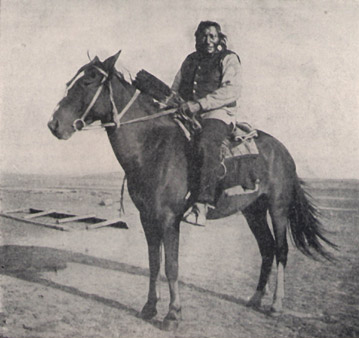When Wheeler was on the Marias, he traveled with anthropologist George Bird Grinnell, and met Wolf Calf, one of the Blackfeet survivors during the fatal encounter with Meriwether Lewis.
Wolf Calf: Alleged Witness
Photo by George Bird Grinnell, (1895), for Olin D. Wheeler, The Trail of Lewis and Clark. See also Wheeler’s “Trail of Lewis and Clark”.
Wheeler related much of Biddle’s description of Lewis’s exploration of the upper Marias River in July 1806, especially the encounter with eight young Piegan Indians, which turned into the only tragedy of the entire expedition. From the anthropologist George Bird Grinnell he got a photo of Wolf Calf, one of the Indian survivors of that meeting, and Grinnell’s summary of Wolf Calf’s recollections.
Wolf Calf may have been one of the eight Piegan Indians [Blackfeet] encountered by Captain Lewis, Joseph and Reubin Field, and George Drouillard, on Flag Butte above the Two Medicine River, on 26 July 1806. This photo was taken when Wolf Calf was about 102 years old. He told anthropologist George Bird Grinnell that he was with the war party that met the first two white men ever seen in the lower Blackfeet country. Their meeting was friendly at first, he said, but their chief told the rest to try to steal some of their things, which resulted in the death of a young man named Side Hill Calf.[1]Olin D. Wheeler, The Trail of Lewis & Clark, 1804-1904, 2 vols. (New York: G.P. Putnam’s Sons, 1904), 2:311-313.
Historians once assumed that this regrettable encounter was the basis of later Blackfeet animosity toward white traders, but it now seems more likely it was Lewis’s innocent remark to the Piegan youths that he had promised guns to certain tribes who were the Piegans’ longtime enemies.
From Paris Gibson, the founder of the city of Great Falls, he got an explanation of why, although he had agreed to meet the rest of his contingent at the mouth of the Marias, Lewis and his three companions didn’t simply follow the river back to the Missouri, but instead aimed to reach it downstream from the Marias. “Had he attempted to follow the Marias River,” Gibson pointed out, “he would have encountered interminable difficulties, as the coulees or ravines which make into that stream are very deep, and in many places almost impassable, particularly within forty or fifty miles of the mouth of the river.” The fugitive American’s couldn’t waste time dodging obstacles. Lewis knew pretty well where he was.
Notes
| ↑1 | Olin D. Wheeler, The Trail of Lewis & Clark, 1804-1904, 2 vols. (New York: G.P. Putnam’s Sons, 1904), 2:311-313. |
|---|
Experience the Lewis and Clark Trail
The Lewis and Clark Trail Experience—our sister site at lewisandclark.travel—connects the world to people and places on the Lewis and Clark Trail.
Discover More
- The Lewis and Clark Expedition: Day by Day by Gary E. Moulton (University of Nebraska Press, 2018). The story in prose, 14 May 1804–23 September 1806.
- The Lewis and Clark Journals: An American Epic of Discovery (abridged) by Gary E. Moulton (University of Nebraska Press, 2003). Selected journal excerpts, 14 May 1804–23 September 1806.
- The Lewis and Clark Journals. by Gary E. Moulton (University of Nebraska Press, 1983–2001). The complete story in 13 volumes.


